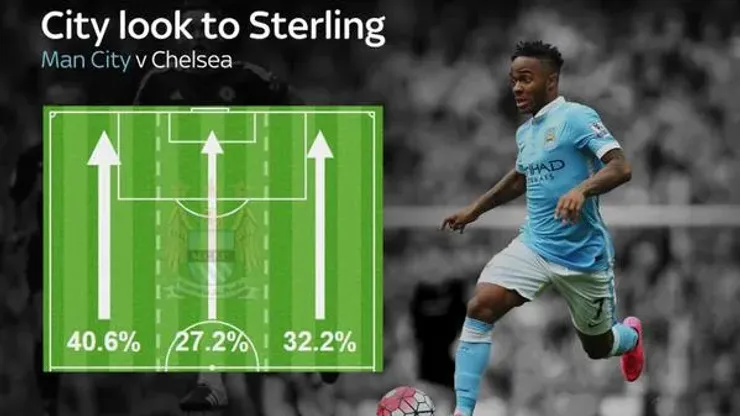Many a pundit and fan has cast Raheem Sterling, Manchester City’s £49 million man, as this season’s pantomime villain in the Premier League. Sterling’s demand of a move away from Liverpool, which is historically a more successful club than City and his schemes to force the move, made Sterling’s transfer one of the most-controversial in recent memory. Yet in all of the discussion of the deal for the 20 year-old, the voices describing his potential positive impact on the Blues efforts to regain the Premier League title were ignored.
A narrative has developed around Sterling as a greedy young player who is indicative of what is wrong in soccer. With the season already started, Manchester City has exploded out of the gates with two successive 3-0 victories. However, the microanalysis of Sterling’s play from some quarters has been off-the-mark. We’ve read that he is a bad finisher and has added little to the Blues attack.While his finishing has been poor, his impact on City’s success after two matches cannot be understated.
Much of the discussion around Manchester City’s start, including Sunday’s 3-0 thumping of defending champion Chelsea, has revolved around the creativity of David Silva and the revival of Yaya Toure. Both of these players have contributed mightily to the Blues cause but much of the impact both have made has come down to Sterling’s presence on the pitch.
SEE MORE: Read Manchester City’s 2015/16 season preview.
Sterling’s ability to make runs and pull players out of position has cleared space for Silva, giving the diminutive Spaniard another outlet with which to play diagonal balls in attacking areas. Two seasons ago, when City won the title playing a 4-4-2, Silva struck up a great partnership with compatriot Alvaro Negredo, whose movement was excellent. Last season, the Blues missed that whether playing in a 4-4-2 with a second striker playing alongside Sergio Aguero, or in a 4-5-1 with Samir Nasri or Frank Lampard flanking Silva in attacking parts of the pitch. Sterling’s movement has also created space for Toure sitting in the center of midfield.
Another clear beneficiary of Sterling’s presence has been Aleksandar Kolarov whose marauding runs down the left flank for the Blues has been the greatest change to the City attack thus far this season. Kolarov, now in his sixth season with the club, has often been criticized for being a shaky defender but his work product going forward has never been in question. Few players in English football have as strong a left foot or can deliver as accurate a cross from wide areas as the Serbian international.
Kolarov has had a devastating impact on the opposition in the first two matches of the season. Sterling’s ability to draw defenders inside with mazy runs and to play well-weighted passes into Kolarov’s path have aided the Serbian’s revival.
Sterling’s pace was on full display early in the second half Sunday against Chelsea. Twice in the first three minutes after halftime, he blew by Branislav Ivanovic, drawing contact and fouls in dangerous areas. But pace is just one of Sterling’s assets which is why he has already been more impactful for the club than the likes of Scott Sinclair. His movement, including an ability to cut inside at the right time, and the understanding he has already developed with Kolarov and Silva have made the left side Manchester City’s attack appear unstoppable.
These are still early days in the Blues attempt to recapture the Premier League crown. Without a doubt significant challenges remain, but the returns thus far have been beyond promising – they have been a revelation and at this rate £49 million might look like a bargain for the former Liverpool star.
200+ Channels With Sports & News
- Starting price: $33/mo. for fubo Latino Package
- Watch Premier League, Women’s World Cup, Euro 2024 & Gold Cup
The New Home of MLS
- Price: $14.99/mo. for MLS Season Pass
- Watch every MLS game including playoffs & Leagues Cup
Many Sports & ESPN Originals
- Price: $10.99/mo. (or get ESPN+, Hulu & Disney+ for $14.99/mo.)
- Features Bundesliga, LaLiga, Championship, & FA Cup
2,000+ soccer games per year
- Price: $5.99/mo
- Features Champions League, Serie A, Europa League & Brasileirāo
175 Premier League Games & PL TV
- Starting price: $5.99/mo. for Peacock Premium
- Watch 175 exclusive EPL games per season






